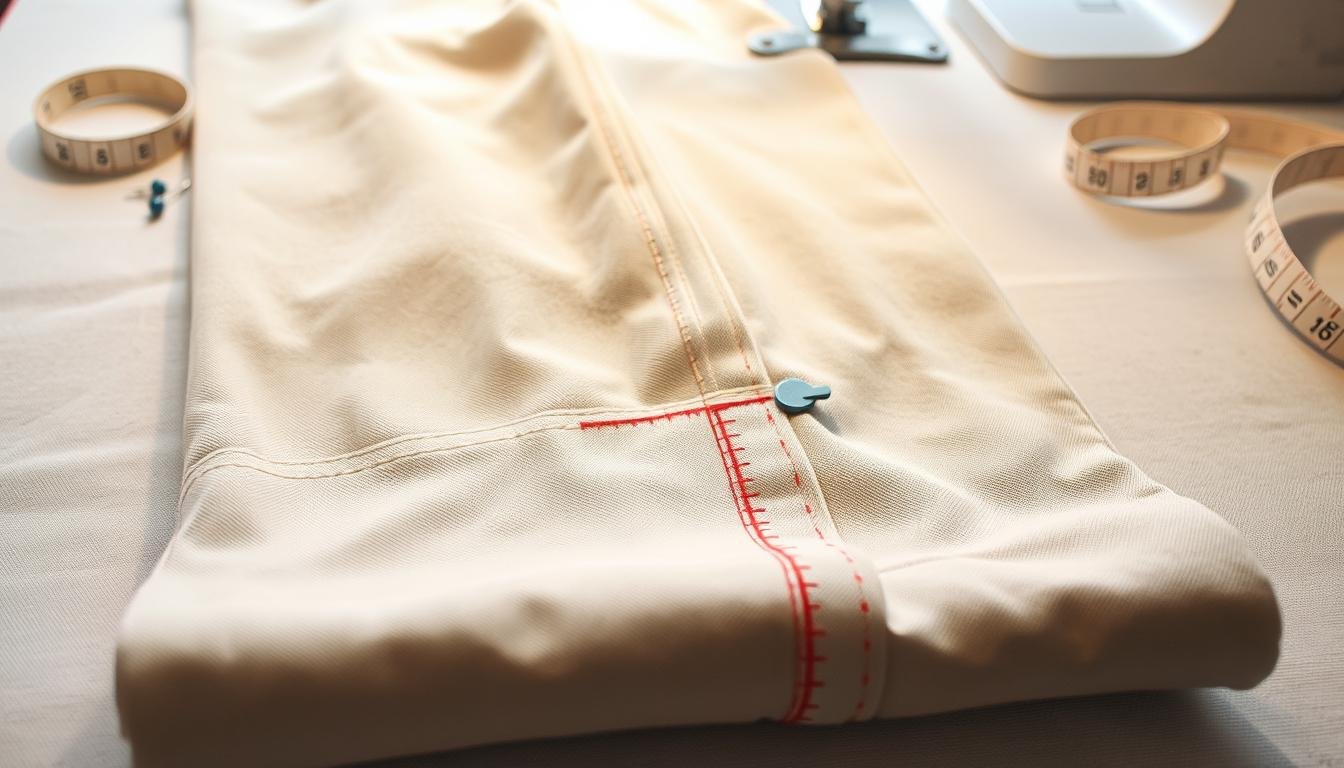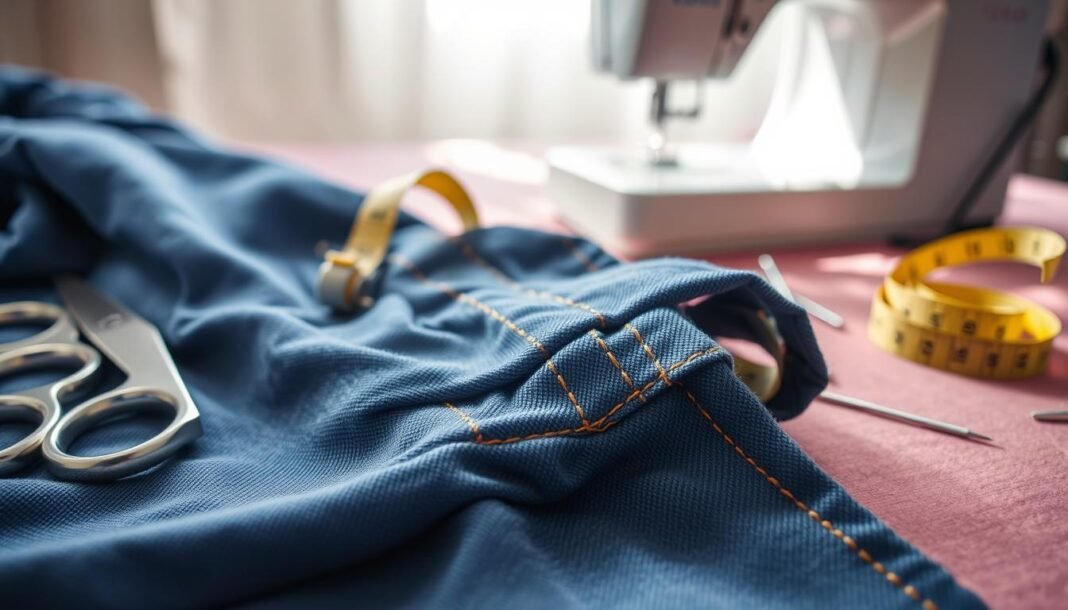Learn to hem pants at home with this easy guide. You can fix new trousers or old favorites that are too long.
This tutorial will teach you how to hem pants like a pro. You’ll save money and get the perfect fit without a tailor.
A close-up scene of a pair of pants being hemmed showcases sewing tools like scissors, measuring tape, and needles scattered around, with a sewing machine in the background. The fabric is vibrant and textured, highlighting the methodical process of adjusting the length, with threads and pins visible for detail. Soft natural light illuminates the workspace, emphasizing the craftsmanship involved in DIY sewing.
Hemming pants might seem hard at first. But with practice, it becomes a fun project.
You’ll soon be able to make all your pants fit just right. This skill will give your outfits a polished look.
Understanding Different Hemming Techniques
Hemming is key for pants alteration. It affects how your pants look and feel.
There are many ways to hem pants. Blind hems, rolled hems, and cuffed hems are popular options.
The best method depends on the fabric and style you want.
Blind hems are excellent for formal wear. They create a nearly invisible seam.
Rolled hems are quick and easy. They work well for casual pants.
Cuffed hems add a personal touch. You can play with different cuff widths.
Knowing these methods helps you make smart choices. You can pick the right one for your needs.
The right hem can make your pants fit perfectly. It can also flatter your figure and boost your style.
Essential Tools and Materials for Hemming
Hemming pants is easy with the right tools. You’ll need scissors, measuring tape, pins, and sewing needles.
Fabric and thread choice is key. Match the thread color to the fabric of your pants.
Pick the correct needle size for your fabric. Adjust sewing machine settings accordingly.
Sharp scissors are a must-have. They make trimming fabric precise and easy.
Use a flexible measuring tape. It helps you get the right pants length.
Pins hold the fabric in place while sewing. Choose the right needle for smooth stitching.
With these hemming tools and sewing supplies, you’ll create perfect pant hems.
Preparing Your Pants for Hemming
Measure your pants before hemming. Try them on with the shoes you’ll wear them with.
Use a tape measure to find the ideal length. Measure from the waistband to where you want the hem.
Now, it’s time to mark the fabric. Fold the pants along the existing hem crease.
Use a fabric pen to draw a line for the new hem. This hem preparation step is key for a clean finish.
A close-up view of a pair of pants laid flat on a sewing table, with a fabric marking tool highlighting the hemline, surrounded by sewing pins and a measuring tape, soft natural light illuminating the fabric textures.
Pay close attention to details when hemming pants. Careful prep will make your pants look great.

Step-by-Step Guide to Hand Hemming Pants
Hand-hemming pants is a valuable skill to learn. It lets you adjust pants to fit you better.
Start by threading your needle and tying a knot. Fold the pant leg to the correct length.
For an invisible hem, use the slip stitch. Put the needle into the fabric’s inside.
Pull the thread through to make a hidden stitch. Keep doing this around the pant leg.
The catch stitch is suitable for a strong hem. Make tiny stitches inside the pant leg.
These stitches will show inside but not outside. This makes a secure hem.
Take your time and make even stitches. With practice, you’ll get better at hand hemming pants.
Using a Sewing Machine for Faster Hemming
Sewing machines make hemming pants quick and easy. They create a neat, professional look that’s hard to beat.
Machine hemming is more precise than hand-stitching. It gives consistent results that rival a tailor’s work.
Set up your machine correctly for hemming. Adjust stitch length and tension for a clean hem.
Try a blind hem foot for nearly invisible stitches. Change stitch settings to create different hem styles.
Sew at a steady pace, guiding the fabric gently. Don’t pull or tug, as this can warp the fabric.
Practice makes perfect with machine hemming. Soon, you’ll create durable and attractive hems with ease.
Troubleshooting Common Hemming Issues
Flawless hems can be tricky but don’t worry. We have solutions for common hemming problems.
Uneven hemlines may result from poor stitching tension. Adjust your machine’s tension and re-mark the hem to fix this.
For puckered fabric, check if your machine is threaded correctly. Try using a needle made for your fabric type.
Stretchy knits and silks need special care when hemming. Use a double-needle or hemming tape for a smooth finish.
With these tips, you’ll soon be sewing perfect hems. Practice makes perfect!
FAQ
What are the different hemming techniques I can use for pants?
Pants can be hemmed using blind, rolled, or cuffed techniques. Your choice depends on the fabric and desired style.
What tools and materials do I need to hem the pants?
You’ll need scissors, measuring tape, pins, sewing needles, and thread. Choose the right thread and fabric for a lasting finish.
How do I prepare my pants for hemming?
Measure and mark the desired length accurately. Consider different shoe heights for even hems.
Can I hem pants by hand, or do I need a sewing machine?
Both hand hemming and machine sewing work for pants. Hand hemming suits beginners and minor changes.
Sewing machines offer faster, more consistent results for more significant projects.
What are some common hemming issues, and how can I fix them?
Common issues include uneven hems, puckered fabric, and tricky stretchy materials. Learn solutions for pro-looking results.
You may also read: Never Miss a Birthday with a Digital Calendar
